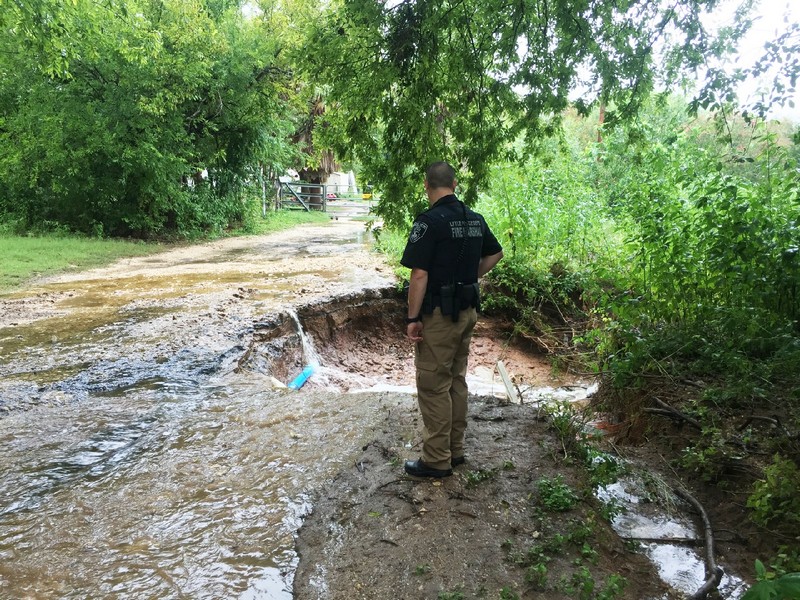After heavy rains, one Lytle resident woke up to find a huge sink hole near her driveway.  The sink hole was reported this Sunday, September 9 around 10 am.
The sink hole was reported this Sunday, September 9 around 10 am.
“It’s pretty darn big, about 10-12 feet wide,” said Lytle Police Chief Richie Priest. “It’s near the intersection of San Jose and Hildago.”
According to the U.S. Geological Survey, Sinkholes can vary from a few feet to hundreds of acres and from less than 1 to more than 100 feet deep. Some are shaped like shallow bowls or saucers whereas others have vertical walls; some hold water and form natural ponds.
The following is additional information regarding sink holes from USGS.gov:
A sinkhole is an area of ground that has no natural external surface drainage–when it rains, all of the water stays inside the sinkhole and typically drains into the subsurface.
Typically, sinkholes form so slowly that little change is noticeable, but they can form suddenly when a collapse occurs. Such a collapse can have a dramatic effect if it occurs in an urban setting. This USGS picture shows a sinkhole that opened up too close to someone’s home in Florida.
The most damage from sinkholes tends to occur in Florida, Texas, Alabama, Missouri, Kentucky, Tennessee, and Pennsylvania. The picture to the left shows a sinkhole that quickly opened up in Florida, apparently eating a swimming pool, some roadway, and buildings.
Types of sinkholes
Dissolution Sink Holes: Dissolution of the limestone or dolomite is most intensive where the water first contacts the rock surface. Aggressive dissolution also occurs where flow is focused in preexisting openings in the rock, such as along joints, fractures, and bedding planes, and in the zone of water-table fluctuation where groundwater is in contact with the atmosphere.
Cover-subsidence sinkholes: These tend to develop gradually where the covering sediments are permeable and contain sand. In areas where cover material is thicker or sediments contain more clay, cover-subsidence sinkholes are relatively uncommon, are smaller, and may go undetected for long periods.
Cover-collapse sinkholes: These may develop abruptly (over a period of hours) and cause catastrophic damages. They occur where the covering sediments contain a significant amount of clay. Over time, surface drainage, erosion, and deposition of sinkhole into a shallower bowl-shaped depression.
Human-induced Sinkholes: New sinkholes have been correlated to land-use practices, especially from groundwater pumping and from construction and development practices. Sinkholes can also form when natural water-drainage patterns are changed and new water-diversion systems are developed. Some sinkholes form when the land surface is changed, such as when industrial and runoff-storage ponds are created. The substantial weight of the new material can trigger an underground collapse of supporting material, thus causing a sinkhole. The overburden sediments that cover buried cavities in the aquifer systems are delicately balanced by groundwater fluid pressure. The water below ground is actually helping to keep the surface soil in place. Groundwater pumping for urban water supply and for irrigation can produce new sinkholes In sinkhole-prone areas. If pumping results in a lowering of groundwater levels, then underground structural failure, and thus, sinkholes, can occur.
Lytle resident finds large sink hole beside roadway

